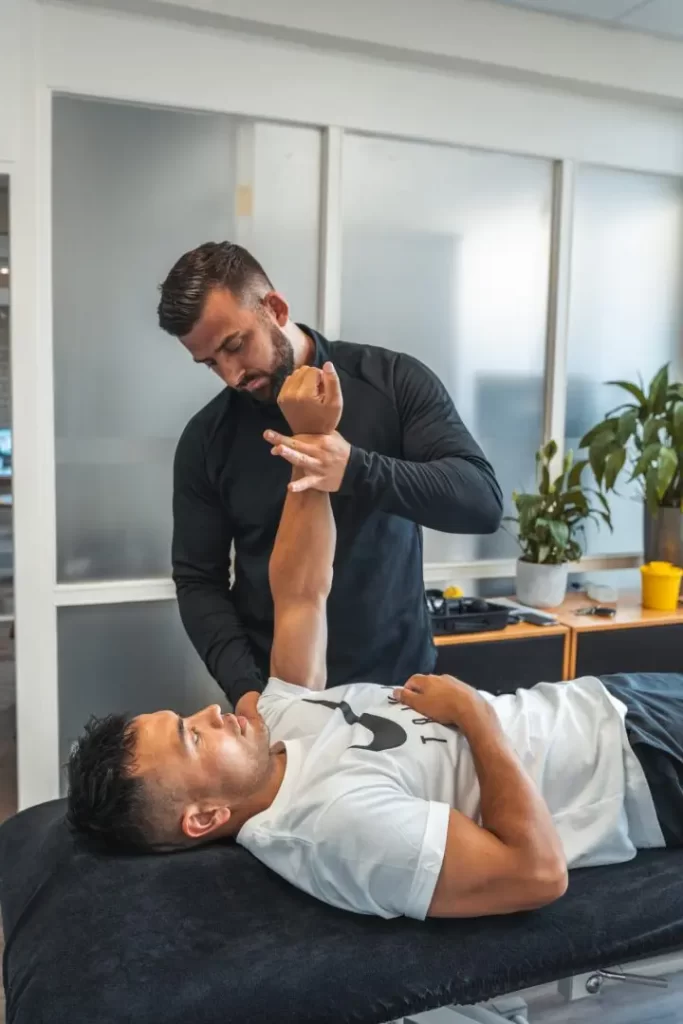Complex ankle fracture
A fracture of the ankle or lower leg can have a major impact on daily life. In many cases, a surgical procedure is needed to reposition the structures of the ankle and restore stability. A commonly used technique for this is the ORIF (Open Reposition and Internal Fixation) procedure. After surgery, an intensive rehabilitation process begins to restore mobility, strength and stability to the joint. At Fysio Fitaal Tilburg, we guide you with individually tailored rehabilitation, aimed at optimal recovery and a safe return to daily activities or sports.

What is an ORIF procedure?
An ORIF (Open Reposition and Internal Fixation) is a surgical technique used for complex fractures of the ankle or lower leg. During this procedure, the fractured bone is accurately returned to its anatomical position and then fixed internally with metal implants, such as screws, plates or intramedullary pins. This ensures stability and promotes a controlled healing process.
Risk factors
Contact and jumping sports such as football, basketball and skiing increase the risk due to sudden changes in direction and impact. Accidents in traffic, motorcycling or at work can lead to serious fractures due to high forces on the bone.
Origination mechanism
Fractures of the ankle or lower leg often occur as a result of high-impact trauma, such as a fall, a traffic accident or a sports injury where extreme rotation or direct force is applied to the bone. In addition, fractures can also occur in less violent incidents when there is reduced bone quality, such as osteoporosis.
Diagnosis and examination
If an ankle or lower leg fracture is suspected, investigations are carried out in hospital. This starts with a physical examination in which swelling, stance abnormalities and pressure pain are assessed. Next, imaging techniques such as X-rays and, in some cases, a CT scan or MRI are used to determine the severity and type of fracture. Depending on the complexity of the fracture, the orthopaedic surgeon determines whether an ORIF procedure is necessary. Because of the severity of the symptoms and immobility in the initial phase, physiotherapy is not initially used; the focus is on medical stabilisation and wound healing.
Treatments and prognosis
At Fysio Fitaal Tilburg, we offer structured and informed rehabilitation for patients after an ORIF procedure. Our treatment plan is tailored to the individual situation and functional goals.
In the first phase, the focus is on pain management, anti-inflammation and early mobilisation within the allowed load capacity. In addition, work is done on improving wound healing and muscle activation with isometric exercises. There is also time for education on load and the use of walking aids.
In the recovery phase, joint mobility is further increased by mobilisation techniques and muscle-strengthening exercises with resistance. Balance training is also important, as is gait training to restore a normal gait pattern.
During the functional rehabilitation phase, strength building is further optimised through functional forms of exercise. These can range from everyday activities to work- and sports-related loads. Activities such as climbing stairs, turning and jumping loads are built up step by step.
For athletes, there is an additional performance phase in which sports-specific strength and conditioning training is used to promote a safe return to sport. Plyometric and reactive exercises improve explosiveness and speed, while impact loading is built in preparation for dynamic movements. Final testing monitors functional symmetry to facilitate a safe return to sport.
Making an appointment at FysioFitaal
We work from multiple locations in Tilburg, always close by for professional and accessible physiotherapy. Fill in the contact form and we will contact you soon. Together, we will work on your recovery!

